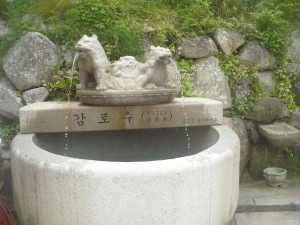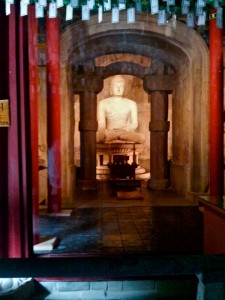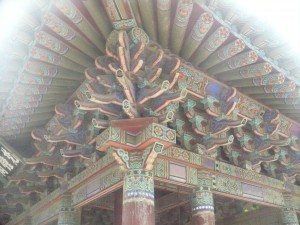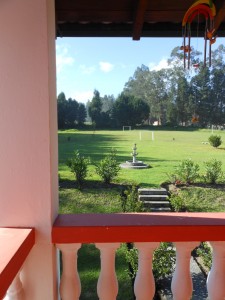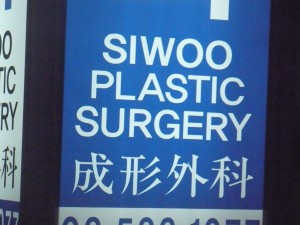I was fortunate enough to travel (5 hours) southeast of the Korean Peninsula to the wonderful cities of Gyeong-ju and Pohang (the latter to be described in a later post. . . trust me, the stories are worth the wait). Around twenty other English Village teachers as well as our wonderful coordinator were also in for the once-in-a-lifetime journey (though I suppose I could and should go back to see the sites I missed). A bit of back history of Gyeong-ju: the area is known as a historical site that was once the “cradle” of the famous Silla Kingdom (dating 1st century BCE to the 10th century, CE I believe) and it is also home to absolutely beautiful Buddhist temples, royal gardens, excavation sites, and equally stunning works of Korean architecture. The night in Gyeong-ju was spent in a “pension,” a traditional Korean lodging guest house (luckily, ours was furnished with a modern kitchen and bathroom, while sleeping was done as tradition–on the floor, which was surprisingly comfortable).
Something that I found endlessly amusing while in Gyeong-ju (as well as Pohang, but more on that later as previously mentioned) was the shock and awe a large portion of people had when they saw foreigners who were not of Asian descent (while Gyeong-ju and Pohang are popular tourist sites, they are primarily popular with Chinese and Japanese tourists, there are very few Western tourists). I cannot count the amount of times a Korean (most of the time a middle-aged woman) would approach me or another person in the group, stare intensely, raise their camera, snap a picture, and then zoom, they run away faster than you would figure to be physically possible. Some simply gawk, but it’s always the Koreans who try to “discreetly” capture the strange looking foreigners on film that always elicit a chuckle from yours truly. Being in the eye of the [Korean people] paparazzi isn’t as bad as Hollywood chalks it up to be. . . *Note that this phenomenon rarely occurs in the Seoul metropolitan area, Koreans there are much more accustomed to seeing/interacting with foreigners than their southern brethren are*
A noteworthy change in pace here in Korea is the fact that the English Village teaching program is over and I have already begun taking classes (a rather late update I admit). I miss seeing my students on a daily basis immensely, however we keep in constant contact (thank you Facebook and Kakao Talk [a very popular Korean messaging system/ social site]) and make lunch/dinner plans at least once a week. It is incredibly strange to shift gears from teaching to being the student (an adjustment that I have yet to fully grasp, I sometimes wake up in a panic because I forgot to plan my lesson for the day, only to remember that I am no longer responsible for that sort of planning).
Below (left to right): The Pension; Water Basin Outside Buddhist Temple, supposedly the water’s taste tells each person about their soul. . . . it tasted quite sour. . .; Buddhist Temple (pictures prohibited. . . shhhhhhh. . . DISCLAIMER: I DO NOT ENDORSE TAKING “ILLEGAL” PHOTOS, BUT EVERYONE ELSE IN THE TEMPLE HAD CAMERAS FLASHING, AND TO MY CREDIT I TOOK THE PHOTO COVERTLY. . . ERM. . . I MEAN I TOOK THE PHOTO OUT OF RESPECT, YA KNOW, FOR FURTHER APPRECIATION?. . . please don’t report me to the South Korean government. . . )
Above (left to right): Excavation Area, complete with interior display of recently discovered [and polished] jewelry; Temple on a Lake; Closeup of Ceiling Tiling



